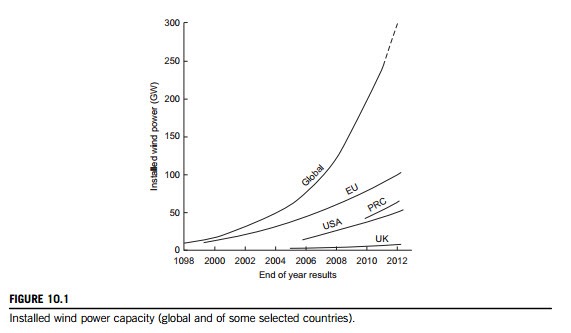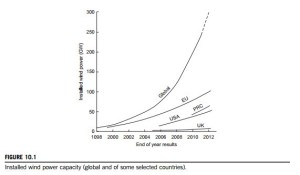Wind Turbines
Introduction
A modern wind turbine is a machine which converts the power available in the wind into electricity. On the other hand, a windmill is a machine which was used to convert wind power to mechanical power. As generators of electricity, wind turbines are usually connected into some form of electrical network and the larger turbines can form a part of the electrical grid. The largest size single turbines used for this purpose can have an output of around 5-6 MW.
Over the past four decades, there has been a remarkable growth in global installed generating capacity. The data given in Figure 10.1 obtained from statistics published by the Global Wind Energy Council (GWEC), the European Wind Energy Association (EWEA), the American Wind Energy Association (AWEA), and others shows the regional and worldwide growth of installed wind power capacity up to the end of 2011. It is interesting to note that the global wind power capacity is now still doubling every 3 years. The biggest regional contributors to this installed growth in wind power are the Peoples Republic of China. According to the GWEC, the develop- ment of wind energy in China in terms of scale is absolutely unparalleled in the world. By the end of 2010, the installed wind power capacity had reached 41.8 GW. Up to May 2009, 80 countries around the world contributed to the generation of wind power on a commercial scale. Predicting the growth of wind power generation is far from reliable. At the end of 2011, the total worldwide wind power capacity had reached 237 GW.
An interesting paper which considers the potential of wind power as a global source of electricity has been presented by Xi, McElroy, and Kiviluoma (2009). The analysis indicates that a net- work of land based 2.5 MW wind turbines restricted to land based, nonforested, ice free, nonurban areas and operating as little as 20% of their rated capacity could supply more than 40 times the cur- rent world capacity of electricity.
Wind characteristics and resource estimation
The Earth receives more energy from the Sun at the equator than at the poles. Dry land heats up (and cools down) more quickly than the oceans. This differential heating and cooling, which is greatest near the equator, drives an atmospheric convection system extending from sea level to the upper atmosphere. The warm air rises, circulates in the atmosphere, and gradually sinks back to the surface in the cooler regions. At the upper levels of the atmosphere, continuous wind speeds are known to exceed 150 km/h. The large-scale motion of the air at altitude causes a circulation pattern with well-known features at sea level such as the trade winds.
The most striking characteristic of wind energy is its variability both spatially and temporally. The variability depends on many factors: climatic region, topography, season of the year, altitude, type of local vegetation, etc. Topography and altitude have a major influence on wind strength. The strength of wind on the high ground and mountain tops is greater than in the sheltered valleys. Coastal regions are often windier than further inland because of the difference in heating between land and sea. The use of available wind resource data is clearly of some importance. Studies have been made in the United States, Europe, and many parts of the world that give an indication of the wind resource (in W/m2) for many locations. In is not feasible (in this book) to give a sensible coverage of these extensive results, but an indication is given for some of the chief organizations which give detailed resource references. These are:
1. For world summaries:
Singh, S., Bhatti, T.S., & Kothari, D.P. (2006). A review of wind-resource-assessment technology. Journal of Energy Engineering, 132(1), 8-14. Elliot, D.L. (2002). Assessing the world wind resource. Power Engineering Review, IEEE, 22(9).
2. For the United States:
Elliot, D.L., & Schwartz, M. (2004). Validation of Updated State Wind Resource Maps for the United States, NREL/CP-500-36200.
3. For Europe:
Troen, I., & Petersen, E.L. (1989). European Wind Atlas, Risø National Laboratory; Denmark:
A significant change has now taken place with the location and rapid building of many wind turbines in coastal waters. Despite the difficult installation environment and increased cost, the main advantages arise from the significantly higher wind speeds and lower wind turbulence. Often centers of population and industry are situated close to coasts so that the cost of electrical transmission is reduced by the more likely shorter distances required by their supply lines.
At any given location temporal variability can mean that the magnitude and amount of the wind strength can change from 1 year to the next. The cause of these changes are still not well under- stood but may be generated by large-scale variations in weather systems and ocean currents.
The proper design and size of a wind turbine will depend crucially upon the site under consideration having a favorable wind. Briefly, to be favorable, the wind would need to be of sufficient strength and duration at an acceptable height. For the locations being considered as possible sites, extended anemometric surveys (lasting over at least a year) are needed to determine the nature of the wind speed distribution with respect to time and height above the ground. These surveys are generally carried out at a fairly standard height of 30 m above the ground and, when required, some sort of extrapolation is made for estimating wind speeds at other heights.1 To assess the frequency of the occurrence of wind speeds at a site, a probability distribution function is often employed to fit the observed data. Several types of these distribution functions are commonly used:
i. the simple single-parameter Rayleigh distribution;
ii. the complicated but slightly more accurate, two-parameter Weibull distribution.
From these data, estimates of power output for a range of turbine designs and sizes can be made. Wind turbine rotors have been known to suffer damage or even destruction from excessive wind speeds and obviously this aspect requires very careful consideration of the worst-case wind conditions so the problem may be avoided.
1The NREL has developed an automated method for wind resource mapping in order to quickly generate wind data. Their mapping technique is based on known empirical relationships between the “free-air” wind speed, 100-200 m above the surface, and the actual surface. A so-called “top-down” method is then used to determine the free-air velocity profiles down to the surface (Schwartz, 1999).
An important issue concerning the installation of wind power plants involves their environmental impact. Walker and Jenkins (1997) have outlined the most significant benefits for installing wind turbines as well as the reasons put forward to counter their installation. It is clear that the benefits include the reduction in the use of fossil fuels, leading to a reduction in the emission of pollutants (the most important of these being the oxides of carbon, sulfur, and nitrogen). Any emissions caused by the manufacture of the wind turbine plant itself are offset after a few months of emission-free operation. Similarly, and importantly, the energy expended in the manufacture of a wind turbine, according to the World Energy Council (1994), is paid back after about a year’s nor- mal productive operation.
Historical viewpoint
It may be of interest to mention a little about how the modern wind turbine evolved. Of course, the extraction of mechanical power from the wind is an ancient practice dating back at least 3000 years. Beginning with sailing ships, the technical insight gained from them was somehow extended to the early windmills for the grinding of corn, etc. Windmills are believed to have originated in Persia in the seventh century and, by the twelfth century, their use had spread across Europe. The design was gradually improved, especially in England during the eighteenth century where mill- wrights developed remarkably effective self-acting control mechanisms. A carefully preserved brick built tower windmill, shown in Figure 10.2, a classic version of this type, still exists on Bidston Hill near Liverpool, United Kingdom, and was used to grind corn into flour for 75 years up until 1875. It has now become a popular historical attraction.
The wind pump was first developed in Holland for drainage purposes, while in the United States, the deep-well pump was evolved for raising water for stock watering. Most windmills employ a rotor with a near horizontal axis, the sails were originally of canvas, a type still in use today in Crete. The English windmill employed wooden sails with pivoted slats for control. The US wind pump made use of a large number of sheet-metal sails (Lynette and Gipe, 1998). The remarkable revival of interest in modern wind-powered machines appears to have started in the 1970s because of the so-called fuel crisis. A most interesting brief history of wind turbine design is given by Eggleston and Stoddard (1987). Their focus of attention was the use of wind power for generating electrical energy rather than mechanical energy. A rather more detailed history of the engineering development of windmills from the earliest times leading to the introduction of the first wind turbines is given by Manwell et al. (2009).

